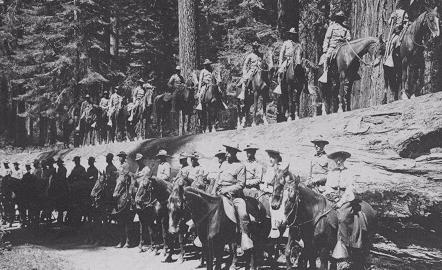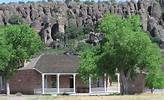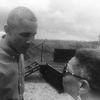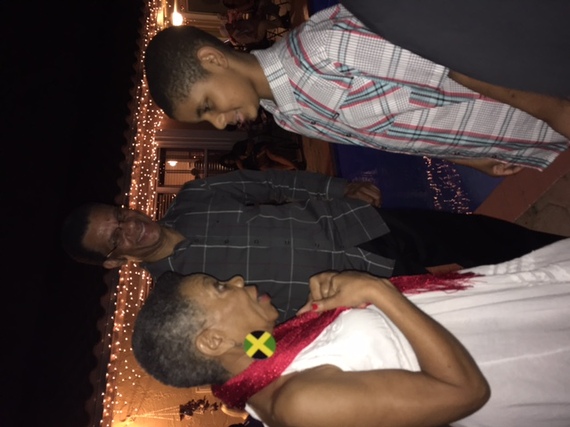"Discovering the Buffalo Soldiers in the archives at Yosemite was like stumbling into family you don't know you have, in a foreign land."
Ranger Shelton Johnson's description in our newsletter, Pickup & GO!, in the late 1990s was ringing through my mind as I thought about how I could most effectively respond to this e-mail:
"The National Park Service is studying the role of the Buffalo Soldiers in the early years of the National Park System. Our study team is collecting information from the public to better understand the Buffalo Soldiers and their work as it relates to our national parks, current efforts to tell those stories, and opportunities to enhance and further commemorate Buffalo Soldier history." Comment here.

The Buffalo Soldiers were instrumental in protecting Yosemite and Sequoia National Parks at the turn of the 20th Century when the Army ran the parks, before the establishment of the Park Service in 1916.
Wow!! Did I have an earful for them!! It's like being asked how you'd like to honor your greatest heroes of all time. Frank and I have encountered such a preponderance of evidence of the contributions of Buffalo Soldiers in National Parks from Alaska to Texas that I could hardly wait to share with the Park Service in hopes that they will share it with the world.
Then I actually met my brother for the first time. And discovered my 12-year-old nephew!
What force could arrange for these two things to coincide? I feel as if I'm living Ranger Johnson's metaphor.
At Fort Davis National Historic Site in Texas where the Buffalo Soldiers were based from 1867-1885 we entered their barracks, lay on their beds, looked out at the same view the Buffalo Soldiers saw when they guarded the Western Migration, displacing Natives in the process. At the Presidio of San Francisco, we saw where they were garrisoned and stood in the gates from which they rode out to protect Sequoia/Grants Canyon National Park. In Sequoia we walked through Giant Grove and touched the same giant sequoias they touched, including the one Col. Charles Young named after Booker T. Washington. In Yellowstone we visited Mammoth Springs where we have pictures of them riding bicycles in winter. At Klondike Gold Rush National Historical Park In Alaska we walked by their old barrack site and learned that they maintained the peace in the lawless gold rush frontier town to the Yukon.

In 2008 Frank and I toured Fort Davis in awe, and saw the hospital building, this very tree filled with warblers and the hoodoos on the hillside, just as the Buffalo soldiers saw them in the 1880s.
At Fort Davis we learned from the Park Service:
"The most serious problem faced by the Army during the Indian War period was desertion. In 1868 the desertion rate for enlisted personnel was approximately 25 percent. Desertions among White regiments were roughly three times greater than those among Black units. Also, both African American cavalry and infantry regiments had lower rates of alcoholism than their white counterparts. While in the field, both the troopers and their horses faced not only hostile Indians and outlaws, but also extended patrols of up to six months and covering more than 1,000 miles. Adding to their ordeal was the scarcity of water and the extremes of weather common to the southwest. . ."
Turns out that the Buffalo Soldiers were the real "John Waynes" of the west! While John Wayne the movie character enjoys almost universal admiration, few Americans know who the Buffalo Soldiers were and what they contributed to the development of our country.
In 2003 I went to Sequoia National Park to attend the 100th Anniversary Celebration of the Buffalo Soldiers, and the rededication of the Booker T. Washington Giant Sequoia Tree. I met descendants of Captain Charles Young, the leader of the Buffalo Soldiers who protected Sequoia/Grants Canyon National Parks from lumbermen and grazers in 1903, and blazed a trail to the top of Mount Whitney that is still visible today.
The story of how that particular giant sequoia was identified 100 years later includes Booker T.'s great-grandson Ted Jackson, a district superintendent with California State Parks who told me,
"In this position I'm often considered a trail blazer, and now I find that I'm just following in the footsteps of these ancestors."
These stories ran through my mind all weekend.
Then Monday night I went to the party at my friend's house to meet my brother for the first time. The enormity of the occasion overcame me as I approached the house, and entered to a large number of people celebrating our hostess' birthday. I made my way toward her around the pool, bearing flowers and champagne. And no sooner was she embracing me than my brother materialized at my side, beaming, so tall and handsome, my father's face, long gone looking at me with so much love. Wow!!
It feels serendipitous for us to connect at this time, when everything appears so fractious. What might we do together now? It's a good time for us to bond as the American family dedicated to the pursuit of these American values, "one nation, under God, with Liberty and Justice for all." The examples of courage and dedication established by the Buffalo Soldiers and other American leaders must be brought out of the shadows now so that they can inspire us, remind us what we are working toward.
The revered philosopher Joseph Campbell said that a community, a family and even individuals are driven by their myths .The American myth of the brave white man conquering the west is only partly true, and dangerously erases the contributions of other races. The end result is visible in our country today in the ugliest way, with many white men erroneously claiming that they built America to the exclusion of everyone else.
The Buffalo Soldiers' legacy in multiple park units deserve to be connected in a Trail similar to the National Underground Railroad Network to Freedom, so that when you're in one of these parks, you learn about the other parks where they made history. The stories need to be shared in the media, in organizations and personally until the Buffalo Soldiers are as well-known and highly regarded as "John Wayne."
The American myth desperately needs to be balanced with our irrefutable, multi-ethnic legacy on the land. YOU can play a role by submitting your comments to the Park Service before Dec. 31.


